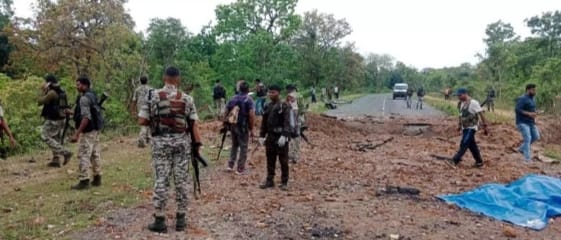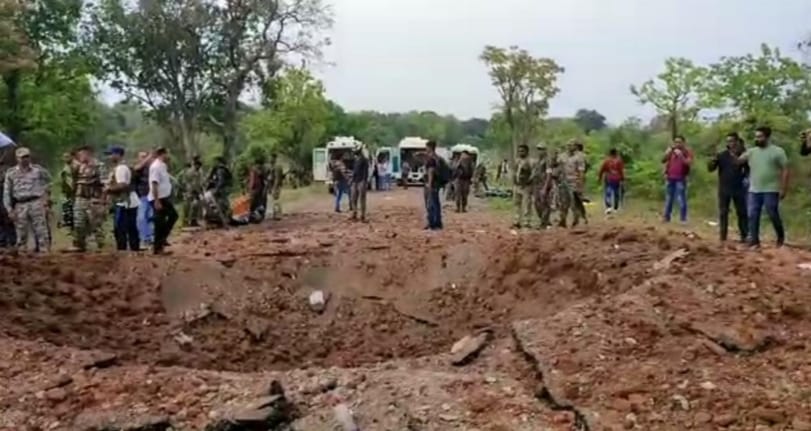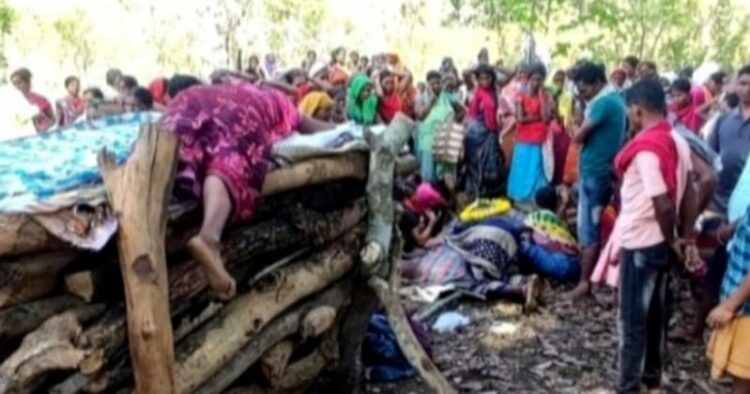It’s been said that a ‘Picture says a thousand words’, a similar kind of picture that explains the unbearable sorrow of the tribals, emerged in the Kaasauli/Nirma village of Dantewada in Chhattisgarh On April 27 last month, when a tribal woman Reshama, the widow of a District Reserve Guard (DRG) Jawan Lakhmu Ram Madkami was seen laying over his body at the time of the latter funeral.
The heart-wrenching scene that took the whole village in tears explains a lot about the current State of the tribals, residing in one of the remotest parts of the country where killings and bloodshed unleashed by the left-wing extremists is a common phenomenon over the last few decades.
Jawan Lakhmu Ram Madkami (39) was one among those who got martyred in the deadly IED (Improvised Explosive Device) attack that occurred on April 26 afternoon between Aranpur-Sameli road and a few kilometres away. There are others too who were waiting for the bodies of their loved ones who got killed in the explosion.
These men from DRG, who are better identified as ‘sons of the soil’ in fact, are no exception, and there are thousands who laid their lives combating the so-called revolution being fuelled by the pioneers of equality who dream of uprooting the parliamentary democracy by force and of establishing a ruthless autocracy by walking the path of their Ideological master Mao.

Ironically, these so-called champions of equality who, with their agenda-driven propaganda, left no stone unturned to justify the violence unleashed by these extremists and termed it a ‘war of the deprives’ who are fighting to safeguard their lands and identity (Jal, Jungle, Zameen) forgets that it is the same masses who have suffered the most on whose behest they justify their cowardice.
If we take only the figures from Chhattisgarh alone (the most affected State in the country), around 1700 tribals from the State have so far perished in the Maoist violence over the last two decades. These killings included hundreds of farmers and youths who were seeking a way out from the clutches of revolution that had ultimately drove their generations into the darkness of violence and bloodshed. Most of them had either been killed in action or had been killed by the Ultras branding them as Informers.
The scale of the violence can be better understood by the fact that in just a span of fifteen years, i.e (2004- 2021), more than 6000 civilians had lost their lives in the violence relating to Maoism. These statistics are provided by the Government, which does not include those killings which had never been reported.
In all, around 12000 people, including around 9300 civilians, have so far been killed in the Maoist violence. This includes around 2700 security personnel who laid down their lives fighting left-wing extremism over the years. Again these statistics are prepared by the Government of India, and the overall persons killed in the violence is suspected to be more because there are cases that are never reported due to the fear casted by the Maoist in the villagers.
If that alone is to be considered, then this is the highest casualties figures that the country has ever suffered to date in any form of war, which suggests the amount of damage it has ultimately done to the country’s internal security over the years.

Though the irony is even that the left-wing extremism has already done immense damage to the region under its effect, there are hundreds who still advocates for a peace process with the Maoists. These self-proclaimed champions of peace assert that the root cause of the issue is that the local population sympathise with the Maoist cause; thus, it needs to be heard thoroughly.
However, in their biased assessment of the situation on the ground, these so-called pioneers of equality forget that a large chunk of the locals who reside in these unfamiliar terrain has already suffered a lot due to the one-sided violence being unleashed upon them by the Maoists for decades and now they slowly realise that it’s due to the obstruction caused by the Ultras that they have been deprived from the mainstream development works and basic necessities.
Specifically, there is no doubt that the tightened security measures and development work carried out during the current central regime have instilled a ray of hope among the locals that their fate does not seal in the violence of the Maoist movement alone, and there is a possible light at the end of the tunnel.
One example of this overhaul change can be understood by the development that took place in the Swabhiman Anchal region of adjoining Odisha, where the situation on the ground has improved drastically after the inauguration of the Gurupriya bridge, which ultimately eased the access of around 30000 tribal dominated population to the mainstream. As a result, the menace of left-wing extremism has declined briskly in the region, and thousands of Maoist sympathisers have shunned the path of violence and joined the mainstream in the last two years alone.
Similar development works along with the establishment of security camps have also been made sure in the Maoist bastion of the Bastar region of Chhattisgarh as well, which has ultimately confined them to a much smaller region than what they used to govern a decade ago. These development works and tightened security measures have driven the Maoists towards targeting innocent civilians and killing them in cold blood.
As a result, around three dozen civilians have been killed by the Maoist in the last one and a half years alone. This killing includes 3 BJP functionaries of the State, including the vice-president of Narayanpur, Saagar Sahu, who was shot dead by the cadres of CPI-M at his residence in Chote-Dongarpur of Narayanpur on February 10.
Suppose Experts are to be believed this change of strategy is a forced one, which will make a huge dent in the already weakening movement in the State, in fact. In that case, these killings have been slowly turning the tides against the so-called defenders of the land who had been somehow being successful in keeping the masses under its umbrella by hook or crook over decades.
As far as their capabilities is concerned, there is no doubt that the struggle against the Maoist in their strongest citadel will be a long one, and there will be no natural death of the movement which can be forecasted, unlike the Northern States like Bihar and Jharkhand,
Though having said that, it is also a fact that the perception among the locals and among the countrymen in general about the so-called revolution of equality is changing briskly, which is slowly but effectively snatching away the major weapon of their urban counterparts who had been providing vital coverfire to the movement on the basis of their agenda-driven propaganda for decades.
They need to understand that the sympathies of the locals, along with the masses in general, are turning with the families of fallen Heroes like Lakhmu Ram; the sooner they understand it, the more it will be in the interest of everyone, including the Maoists.


















Comments